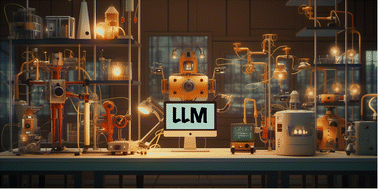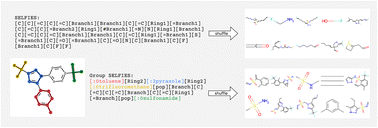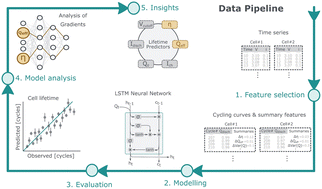Themed collection Digital Discovery – Editors Choice Collection 2023

A rigorous uncertainty-aware quantification framework is essential for reproducible and replicable machine learning workflows
The capability to replicate the predictions by machine learning (ML) or artificial intelligence (AI) models and the results in scientific workflows that incorporate such ML/AI predictions is driven by a variety of factors.

Digital Discovery, 2023,2, 1251-1258
https://doi.org/10.1039/D3DD00094J
14 examples of how LLMs can transform materials science and chemistry: a reflection on a large language model hackathon
We report the findings of a hackathon focused on exploring the diverse applications of large language models in molecular and materials science.

Digital Discovery, 2023,2, 1233-1250
https://doi.org/10.1039/D3DD00113J
Recent advances in the self-referencing embedded strings (SELFIES) library
We describe the current state of the SELFIES library (version 2.1.1), and, in particular, the advances and improvements we have made in its underlying algorithms, design, and API.

Digital Discovery, 2023,2, 897-908
https://doi.org/10.1039/D3DD00044C
The materials experiment knowledge graph
Graph representations of hierarchical knowledge, including experiment provenances, will help usher in a new era of data-driven materials science.

Digital Discovery, 2023,2, 909-914
https://doi.org/10.1039/D3DD00067B
Towards a modular architecture for science factories
Advances in robotic automation, high-performance computing, and artificial intelligence encourage us to propose large, general-purpose science factories with the scale needed to tackle large discovery problems and to support thousands of scientists.

Digital Discovery, 2023,2, 1980-1998
https://doi.org/10.1039/D3DD00142C
Autonomous biomimetic solid dispensing using a dual-arm robotic manipulator
An automated solid dispenser was developed using a dual-arm robot and fuzzy logic controller, mimicking the operations of human researchers.

Digital Discovery, 2023,2, 1733-1744
https://doi.org/10.1039/D3DD00075C
Driving school for self-driving labs
Self-driving labs benefit from occasional and asynchronous human interventions. We present a heuristic framework for how self-driving lab operators can interpret progress and make changes during a campaign.

Digital Discovery, 2023,2, 1620-1629
https://doi.org/10.1039/D3DD00150D
Neural networks trained on synthetically generated crystals can extract structural information from ICSD powder X-ray diffractograms
We used synthetically generated crystals to train ResNet-like models to enhance the prediction of space groups from ICSD powder X-ray diffractograms. The results show improved generalization to unseen structure types compared to previous approaches.

Digital Discovery, 2023,2, 1414-1424
https://doi.org/10.1039/D3DD00071K
A high-throughput workflow for the synthesis of CdSe nanocrystals using a sonochemical materials acceleration platform
A sonochemical Materials Acceleration Platform was implemented to synthesize CdSe nanocrystals under 625 unique conditions (in triplicate) in less than 6 weeks. The modularity of the workflow is adaptable to a variety of applications.

Digital Discovery, 2023,2, 1042-1057
https://doi.org/10.1039/D3DD00033H
Chemical design with GPU-based Ising machines
Ising machines are used to create molecules with desired properties. GPU-based Ising machines are shown to outperform qubit-based ones in terms of scalability.

Digital Discovery, 2023,2, 1098-1103
https://doi.org/10.1039/D3DD00047H
Automated patent extraction powers generative modeling in focused chemical spaces
Automated patent mining creates domain-specific datasets of molecular structures for generative modeling with limited human intervention.

Digital Discovery, 2023,2, 1006-1015
https://doi.org/10.1039/D3DD00041A
Automated electrolyte formulation and coin cell assembly for high-throughput lithium-ion battery research
We present ODACell, an automated electrolyte formulation and coin cell assembly system for accelerated battery research.

Digital Discovery, 2023,2, 799-808
https://doi.org/10.1039/D3DD00058C
Designing catalysts with deep generative models and computational data. A case study for Suzuki cross coupling reactions
Variational-autoencoders with an additional predictor neural-network and gradient-based optimization allow us to generate new Suzuki-catalysts and predict the binding energies.

Digital Discovery, 2023,2, 728-735
https://doi.org/10.1039/D2DD00125J
Group SELFIES: a robust fragment-based molecular string representation
Group SELFIES is a molecular string representation that incorporates tokens which represent substructures while maintaining robustness, which improves the performance of molecular generative models.

Digital Discovery, 2023,2, 748-758
https://doi.org/10.1039/D3DD00012E
A fully automated platform for photoinitiated RAFT polymerization
The use of robotic instrumentation and Python scripts allows for fully automated and robust combinatorial polymer synthesis.

Digital Discovery, 2023,2, 219-233
https://doi.org/10.1039/D2DD00100D
Uncertainty-aware and explainable machine learning for early prediction of battery degradation trajectory
We present an interpretable uncertainty-aware machine learning model to predict battery degradation trajectories. Using LSTM Recurrent Neural Networks, we reach an RMSE of 106 and MAPE of 10.6%.

Digital Discovery, 2023,2, 112-122
https://doi.org/10.1039/D2DD00067A
About this collection
This collection highlights some of the very best work published in Digital Discovery in 2023, carefully chosen by our dedicated editorial team and the Editor-in-Chief, Alán Aspuru-Guzik.